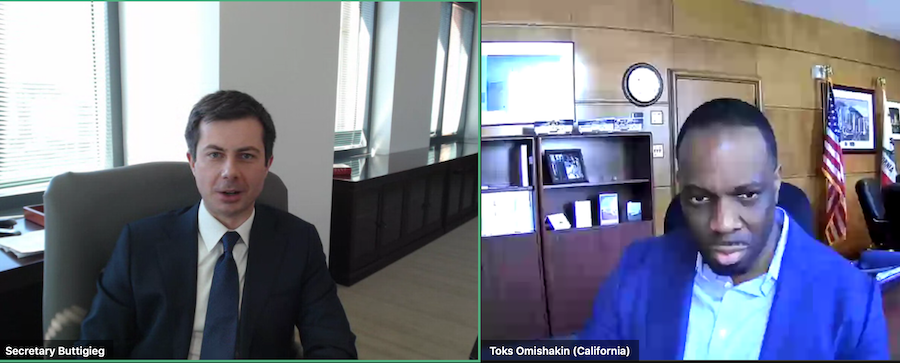Safety, equity, economic development and climate change are the pillars that will drive federal transportation policy, along with a strong emphasis on breaking down boundaries both within the U.S. Dept. of Transportation, between other federal departments, and with state and local agencies.
“We are eager and committed to work with leaders at every level—state, local, territorial, tribal and federal,” said Pete Buttigieg, the U.S. DOT secretary, addressing the American Association of State Highway and Transportation Officials at its annual meeting Feb. 25.
He acknowledged the longstanding issue of reliable federal funding for the industry, which is “waiting patiently or impatiently for the moment when [infrastructure funding] is no longer a Groundhog’s Day promise but actually delivers generational investment.”
The fact that the transportation sector is the sector causing the most greenhouse gas emissions also means it is the place for the most solutions, he said. Future federal grants will be aimed at projects addressing climate change and environmental justice.
Responding to questions from AASHTO officials, Buttigieg said the DOT will strive to partner with not only states but also municipalities and rural communities. He invoked his time as mayor of South Bend, Ind.: “There are communities that can’t afford a full-time relationship with the feds—we couldn’t.” He referenced the “confounding processes that exist on the federal side” and said, “we should be a little more user-friendly.”
He said that depending on fuel taxes for a sustainable funding pot “is not a long-term solution” and that “some kind of road user assessment” is one option, but should not “punish rural areas where people may need to drive more frequently.”
In response to the point that state transportation departments often handle multiple modes, he said that “we will think across silos across our own organization” and make sure the various departments “are integrated in the ways they interact with state partners.”
Buttigieg hinted that the DOT may consider a dedicated railway trust fund. “That’s something we might have an opportunity to weigh in the process going forward with Congress.”
In regard to climate change, he said that the Biden administration has “a coordinated government setup that’s new even compared to previous administrations that took climate change seriously. For example, the National Highway Traffic Safety Administration and the Environmental Protection Agency “are in the same conversation about what’s happening in cars.” He noted the federal pledge to create half a million new electric vehicle charging stations, and added that “trains and transit will get the right kind of support.”
Buttigieg’s deputy administrators echoed efforts to break down silos. Stephanie Pollack, deputy administrator for the Federal Highway Administration, also discussed transit solutions, electric vehicles, and increasing bus lanes and finding first-last-mile solutions to get to and from transit stations.
Nuria Fernandez, deputy administrator for the Federal Transit Administration, emphasized equity. “Equity is at stake in our policy, and a pillar of recovery.” Noting that some $80 billion in federal aid will come to transit this year, she said DOT will “ensure that disparities that denied people opportunities for so long are removed. Building infrastructure revitalizes communities, but [only through] the lens of environmental justice and equity.”
That infrastructure includes sidewalks, curbs, bike lanes, and bus stops, she added.
Amit Bose, deputy administrator for the Federal Railroad Administration, emphasized safety at the intersections of highways and railroads. He noted a February 2022 deadline for all states to have an action plan regarding high-risk grade crossings. The agency is conducting research with an automobile company to test a system that would alert drivers when they are about to encounter a railroad crossing, he added.
Regarding diversity, he said the FRA will look into creating its own version of an MBE/DBE program.




Post a comment to this article
Report Abusive Comment